
The next skin cream might come from NASA space science
Anti-aging cosmetics research in orbit around the Earth.
Want to avoid premature wrinkles? Drink plenty of water, wear sunscreen, don’t smoke, never frown, and try to limit your time in space.
Astronauts’ skin takes a beating, even without gravity to weigh it down. In fact, astronauts say they tend to have dry, scaly, flaky skin devoid of the natural oils that keep cells supple. However, the cons of spaceflight, which alter the behavior of genes and appear to speed up the aging process, could hold a clue for dermatology researchers, revealing the mysteries behind age-related skin problems.
The unique environment in orbit caught the attention of Colgate-Palmolive, the toothpaste giant that recently expanded into the skincare division.(Opens in a new tab). The company is set to use the International Space Station as a test bed for skin research, following its recent use of the space lab to study oral health.(Opens in a new tab). The space station is a taxpayer-funded national laboratory, so NASA regularly invites research collaborations with private companies(Opens in a new tab).
Human skin tissue culture plates will be launched aboard Northrop Grumman’s Cygnus spacecraft(Opens in a new tab) on an Antares rocket from NASA’s Wallops Flight Facility on Feb. 19(Opens in a new tab). The samples, which are cells from a single donor, will be included in a supply ship containing 8,200 pounds of research equipment and crew supplies. If all goes well, the spacecraft will reach the station on February 21.
Colgate, the parent company of Filorga Cosmetics, Elta MD and PCA Skin, wants to study the molecular and cellular changes underlying skin deterioration in samples exposed to space station microgravity, said Lia Arvantitidou, vice president of personal and skin care. research and development.
An experiment will be conducted using the same samples simultaneously on Earth. Differences in molecular patterns between tissues can reveal clues to the biological mechanisms that occur when our bodies naturally repair skin.
“We believe the findings will help us better identify areas for early intervention in skin health and guide the development of skin care innovations across Colgate-Palmolive skincare brands,” she said during a NASA call with reporters Feb. 10. .
So how did Colgate convince NASA to commit time, lab space, and staff to a study that could produce more anti-wrinkle creams?
Healthy skin helps regulate body temperature and acts as a protective barrier against infection—functions essential for enduring long missions in deep space. And while anti-aging skin treatments may seem like a trip to the Fountain of Youth — or perhaps Botox or the next facial filler — Colgate reps say the thin, fragile skin of older adults makes them more susceptible to cuts and bruises and less able to heal flesh wounds.
“Any loss of functional or structural stability in the skin is also a potential source of other health problems,” Colgate said in a NASA preview of the experiment.(Opens in a new tab) In other words, skin problems are not just skin problems.
NASA has long known that the space station’s low gravity is a stressful environment for objects. Skin lesions are a normal part of life on Earth and occur slowly over decades. But a short period in orbit seems like an overdrive to the aging process.

According to a 2015 study published in the journal Nature(Opens in a new tab). Researchers believe this increase is due to the material’s higher rate of breakdown and circulation, which gives skin its structural support. (Opens in a new tab)
Astronauts are limited in their ability to maintain cleanliness in the same way they can on Earth. The space station crew uses wet wipes to shampoo and dry their hair. There are no washing machines for laundry. These factors also contribute to more frequent cutaneous complications, according to a recent review of the scientific literature in pharmacology and physiology.(Opens in a new tab). (Opens in a new tab)
“Any loss of functional or structural stability of the skin is also a potential source of other health problems.”
Skin conditions suffered by space station crews over the years include psoriasis (a scaly rash); screws that come off. Dermatitis (skin irritation). hypersensitivity Inflammation of the hair follicles. Fungal, viral and bacterial infections. Delayed wound healing. Frostbite; and skin cancer. And NASA found 33 cases of basal and squamous cell carcinomas, two common types of skin cancer, among the 312 astronauts, compared with 27 cases among the 912 controls on Earth. This equates to a nearly tripling rate among astronauts, according to the same article.(Opens in a new tab).
The Colgate samples will consist of human skin cells on a porous surface to mimic the three-dimensional organization of skin tissue. After seven days of growing the scientists’ skin, the plates will arrive at the space station. The tissue groups will be frozen after different time periods of exposure to the low gravity of space. It is then stored at -112 degrees Fahrenheit so scientists can study the samples after their spaceflight.
“What we expect is to see earlier and more dramatic signs of tissue damage and possibly activation of skin repair mechanisms in tissues in microgravity,” Arvantitido said. We also hope to see a change in different genes. »

“Organizer. Social media geek. General communicator. Bacon scholar. Proud pop culture trailblazer.”
